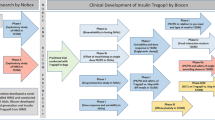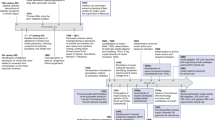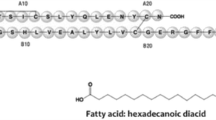Summary
There is a continuing search for improved insulin formulations in order to imitate as closely as possible the physiological pattern of insulin secretion, and thereby to minimise the complications of diabetes mellitus. The major advances achieved to date are in the area of human insulin analogue synthesis resulting from the introduction of recombinant DNA techniques, and in improved delivery systems that utilise noninvasive or minimally invasive modes of administration.
To accommodate postprandial hyperglycaemia, monomeric insulin formulations have been developed, of which insulin lispro (the Lys-Pro analogue) is already approved for clinical use. These formulations have a rapid rate of absorption and, therefore, have to be administered at meal time (unlike the previous short-acting formulations). Their residence time is also about 2-fold shorter than regular human insulin; this minimises the risk of the excessive hypoglycaemic effect that characterises regular human insulin formulations. Certain proinsulin formulations with hepatoselective activity have been developed but were found to be poorly tolerated. The newer proinsulin molecules do not show hepatoselective properties.
In order to generate basal insulin levels, peakless long-acting formulations have been developed, including: a soluble formulation (which upon subcutaneous administration, produces a ‘depot-like’ sustained release mechanism), albumin-bound insulin and cobalt-insulin hexamer formulations. To improve patient compliance the ‘pen’ device was developed for subcutaneous injections. Programmable infusion pumps were developed to avoid repetitive subcutaneous injections.
Great efforts have been made in searching for noninvasive modes of insulin administration that will avoid the need for parenteral administration. These include: oral, colonic, rectal, nasal, ocular, buccal, pulmonary, uterine and transdermal routes of administration. Various enhancers have been tested to increase the bioavailability of each route. At present these alternative routes do not provide clinically relevant substitutes for the subcutaneous mode of administration.
In conclusion, although the newer formulations provide certain advantages, there is still much to be done to further facilitate and improve insulin therapy.
Similar content being viewed by others
References
Zinman B. The physiologic replacement of insulin: an elusive goal. N Engl J Med 1989; 321: 363–70
Matthews DR, Naylor BA, Jones RG, et al. Pulsatile insulin has greater hypoglycemic effect than continuous delivery. Diabetes 1983; 32: 617–21
Bratush-Marrain PR, Komjati M, Waldhausl WK. Efficacy of pulsatile versus continuous insulin administration on hepatic glucose production and glucose utilization in type I diabetic humans. Diabetes 1986; 35: 922–6
Ward GM, Walters JM, Aitken PM, et al. Effects of prolonged pulsatile hyperinsulinemia in humans. Enhancement of insulin sensitivity. Diabetes 1990; 39: 501–7
O’Meara NM, Polonsky KS. Insulin secretion in vivo. In: Kahn CR, Weir GC, editors. Joslin’s diabetes mellitus. 13th ed. Malvern (PA): Lea & Febiger, 1994: 81–90
Malaisse WJ. Metabolic signaling of insulin secretion. Diabetes Rev 1966; 11: 145–59
Tillel H, Shapiro ET, Miller MA, et al. Dose dependent effects of oral and intravenous glucose on on insulin secretion and clearance in normal humans. Am J Physiol 1988; 254: E349–57
Hoffman A, Goldberg A. The relationship between receptor-effector unit heterogeneity and the shape of the concentration-effect profile: pharmacodynamic implications. J Pharmacokinet Biopharm 1994; 22: 449–68
Meglasson MD, Matschinsky FM. New perspective on pancreatic islet glucokinase. Am J Physiol 1984; 246: El–13
Salomon D, Meda P. Heterogeneity and contact-dependent regulation of hormone secretion by individual β cells. Exp Cell Res 1986; 162: 507–20
White JR. The pharmacologic management of patients with type II diabetes mellitus in the era of new oral agents and insulin analogs. Diabetes Spectrum 1996; 9: 227–34
Schernthaner G. Immunogenicity and allergenic potential of animal and human insulins. Diabetes Care 1993; 16(Suppl. 3): 155–65
The Diabetes Control and Complications Trial Research Group. The effect of intensive treatment of diabetes on the development and progression of long-term complications in insulin-dependent diabetes mellitus. N Engl J Med 1993; 329: 977–86
McEvoy GK, editor. Drug information AHFS 97. Bethesda: American Society of Health-System Pharmacists Inc., 1997: 2413
Van Haeften TW, Bolli GB, Dimitriadis GP, et al. Effect of insulin antibodies and their kinetic characteristics on plasma free insulin dynamics in patients with diabetes mellitus. Metabolism 1986; 35: 649–56
Van Haeften TW, Heiling VJ, Gerich JE. Adverse effects of insulin antibodies on postprandial plasma glucose and insulin profiles in diabetic patients without immune insulin resistance: implications for intensive insulin regiments. Diabetes 1987; 36: 305–9
Palmer JP, Asplin CM, Clemens P, et al. Insulin antibodies in insulin-dependent diabetics before insulin treatment. Science 1983; 222: 1337–9
Van Haeften TW. Clinical significance of insulin antibodies in insulin-treated diabetic patients. Diabetes Care 1989; 12: 641–8
Torlone E, Fanelli C, Rambotti AM, et al. Pharmacokinetics, pharmacodynamics and glucose counterregulation following subcutaneous injection of the monomeric insulin analogue [Lys(B28),Pro(B29)] in IDDM. Diabetologia 1994; 37: 713–20
Woodworth JR, Howey DC, Bowsher RR. Establishment of time-action profiles for regular and NPH insulin using pharmacodynamic modeling. Diabetes Care 1994; 17: 64–9
Hooper SA, Bowsher RR, Howey DC. Pharmacokinetics and pharmacodynamics of intravenous regular human insulin. In: Garzone PD, Colburn WA, Motokoff M, editors. Pharmacokinetics and pharmacodynamics: peptides, peptoids and proteins. Vol. 3. Cincinnati: Harvey Witney Books, 1991: 128–37
Brange J, Owens DR, Kang S, et al. Monomeric insulins and their experimental and clinical implications. Diabetes Care 1990; 13: 923–54
Heinemann L, Richter B. Clinical pharmacology of human insulin. Diabetes Care 1993; 16Suppl. 3: 90–100
Brogden RN, Heel RC. Human insulin: a review of its biological activity, pharmacokinetics and therapeutic use. Drugs 1987; 34: 350–71
Home PD, Thow JC, Tubridge FKE. Insulin treatment: a decade of change. Br Med Bull 1989; 45: 92–110
Binder C. Absorption of injected insulin. Acta Pharmacol Toxicol Suppl 1969; 2: 1–87
Hildebrandet P, Brich K. Basal rate subcutaneous insulin infusion: absorption kinetics and relation to local blood flow. Diabetic Med 1988; 5: 434–40
Vora JP, Burch A, Peters JR, et al. Relationship between absorption of radiolabled soluble insulin, subcutaneous blood flow and anthropometry. Diabetes Care 1992; 15: 1484–93
Williams G, Pickup J, Clark A, et al. Change in blood flow close to subcutaneous insulin injection sites in stable and brittle diabetes. Diabetes 1983; 32: 466–73
Linde B. Dissociation of insulin absorption and blood flow during massage of a subcutaneous injection site. Diabetes Care 1986; 9: 570–4
Brange J, Skelbaek-Pederse B, Langkjaer L, et al. Galenics of insulin: the Physico-Chemical and pharmaceutical aspect of insulin and insulin preparations. Berlin: Springer-Verlag, 1987
Kang S, Brange J, Burch A. Subcutaneous insulin absorption explained by insulin’s physicochemical properties: evidence from absorption studies of soluble human insulin and insulin analogues in humans. Diabetes Care 1991; 14: 942–8
Patrick AW, Collier A, Matthews DM, et al. The importance of the time interval between insulin injection and breakfast in determining postprandial glycemic control: a comparison human and porcine insulin. Diabetic Med 1988; 5: 32–5
DiMarchi RD, Mayer JP, Fan L, et al. Synthesis of fast acting insulin based on structural homology with insulin-like growth factor 1. In: Smith JA, Rivier JE, editors. Peptides: chemistry and biology. Proceedings of the Twelfth American Peptide Symposium; Leiden. Leiden: ESCOM, 1992: 26–8
Baker EN, Blundell TL, Cutfield JF, et al. The structure of 2 Zn pig insulin crystals at 1.5 A Resolution. Philos Trans R Soc Lond B Biol Sci 1988; 319: 369–456
Brange J. Insulin preparations. In: Brange J, Skelbabek-Pedersen B, Langkjaer L, et al., editors. Galenics of insulin: the physicochemical and pharmaceutical aspects of insulin preparations. Berlin: Springer-Verlag, 1987: 17–31
Brems DN, Alter LA, Beckage MJ, et al. Altering the association properties of insulin by amino acid replacement. Protein Eng 1992; 5: 527–33
Shaw WN, Su KSE. Biological aspects of a new human insulin analog: [Lys(B28),Pro(B29)]-human insulin [abstract]. Diabetes 1991; 40(Suppl. 1): 464
Radziuk J, Davies J, Pye R, et al. Subcutaneous absorption of fast-acting insulin analogs: kinetics and bioeffectiveness [abstract]. Diabetologia 1992; 35(Suppl. 1): A3
Howey DC, Bowsher RR, Brunelle RL, et al. [Lys(B28), Pro(B29)]-human insulin: a rapidly absorbed analogue of human insulin. Diabetes 1994; 43: 396–402
Brange J, Havelund S, Hommel E, et al. Neutral insulin solutions physically stabilized by addition of Zn+2. Diabetic Med 1986; 3: 532–6
Brems DN, Brown P, Bryant C, et al. Improved stability thorough amino acid substitution. Protein Eng 1992; 6: 519–25
Nijs HGT, Radder JK, Frolich M, et al. In vivo relationship between insulin clearance and action in healthy subjects and IDDM patients. Diabetes 1990; 39: 333–9
Navalesi R, Pilo A, Ferrannini E. Kinetic analysis of plasma insulin disappearance in nonketotic diabetic patients and in normal subjects: a tracer study with 125I-insulin. J Clin Invest 1978; 61: 197–208
Anderson J, Brunelle RL, Pfuetzner A, et al. Reduced frequency of hypoglycemia without loss of glycemic control [abstract]. Diabetes 1996; 45(Suppl. 2): 59A
BastyrIII EJ, Kotsanos J, Vignati L, et al. Insulin lispro (LP) reduced hypoglycemia rate in persons with type II diabetes at high risk for hypoglycemia [abstract]. Diabetes 1996; 45(Suppl. 2): 56A
Braimon J, O’Brien M, Kaulbach H, et al. The insulin analog Lispro effectively treats anti-insulin antibody mediated insulin resistance [abstract]. Diabetes 1996; 45(Suppl. 2): 185A
Radziuk J, Bradley B, Welsh L, et al. Profile of biological activity after subcutaneous administration of mixtures of Lys B29-Pro B29 human insulin (Lispro) in soluble and neutral protamine formulations [abstract]. Diabetes 1996; 45(Suppl. 2): 218A
Galloway JA, Hooper SA, Spradlin CT, et al. Biosynthetic human proinsulin: review of chemistry, in vitro and in vivo receptor binding, animal and human pharmacology studies, and clinical experience. Diabetes Care 1992; 14: 666–92
Galloway JA. Treatment of NIDDM with insulin agonists or substitutes. Diabetes Care 1990; 13: 1209–39
DeFronzo RA. Lilly lecture 1987. The triumvirate: β-cell, muscle, liver: a collusion responsible for NIDDM. Diabetes 1988; 37: 667–87
Nippe A, Walter H, Bachmann W, et al. Intraperitoneal (IP) versus intravenous (IV) application of human proinsulin and insulin in type I diabetics [abstract]. Diabetes 1985; 34(Suppl. 1): 59A
Tilli H, Frank BH, Pekar AH, et al. Hypoglycemic potency and metabolic clearance rate of intravenously administered human proinsulin and metabolites. Endocrinology 1990; 127: 2418–22
Sodoyez-Goffaux F, Sodoyez JC, Koch M, et al. Scintigraphic distribution of 125I labeled proinsulin, split conversion intermediates and insulin in rats. Diabetologia 1988; 31: 848–54
Seigler DE, Olsson GM, Agramonte RF, et al. Pharmacokinetics of long-acting (ultralente) insulin preparations. Diab Nutr Metab 1991; 4: 267–73
Jorgensen S, Vaag A, Langkjaer L, et al. NovoSol Basal: pharmacokinetics of a novel soluble long acting insulin analogue. BMJ 1989; 299: 415–9
Galloway JA, Chance RE. Improving insulin therapy: Achievements and challenges. Horm Metab Res 1994; 26: 591–8
Talaulicar M, Willms B, Rosskamp R. Efficacy of HOE 901 following subcutaneous injection for four days in type I diabetic subjects [abstract]. Diabetologia 1994; 37: A169
Markussen J. Pharmacokinetics and dynamics of albumin-binding insulins. 75 Celebrating the Discovery of Insulin 1996 [abstract]. An international research symposium on diabetes focusing on beta-cell function and insulin action; 1996 Oct 6–9; Toronto, 79
Kurtzhals P, Ribel U. Action profile of cobalt(III)-insulin: a novel principle of protection of potential use for basal insulin delivery. Diabetes 1995; 44: 1381–5
Kraegen EW, Chisholm DJ. Pharmacokinetics of insulin: implications for continuous subcutaneous insulin infusion therapy. Clin Pharmacokinet 1985; 10: 303–14
Scavini M, Schade D. Implantable insulin pumps. Clin Diab 1996; 14: 30–5
Hoffman A, Shaked I, Avramoff A, et al. Pharmacokinetics and pharmacodynamics of trans-endometrial administred peptides and macromolecules. Adv Drug Deliv Rev 1995; 17: 191–203
Matthews DR. Physiological implications of pulsatile hormone secretion. Ann NY Acad Sci 1991; 618: 28–37
Pasolisso G, Sgambato S, Torella R, et al. Pulsatile insulin delivery is more efficient than continuous infusion in modulating islet cell function in normal subjects and patients with type I diabetes. J Clin Endocrinol Metab 1988; 66: 1220–6
Ader M, Bergman RN. Peripheral effects of insulin dominate suppression of fasting hepatic glucose production. Am J Physiol 1990; 258: E1020–32
Giacca A, Fisher S, Shi ZQ, et al. Importance of peripheral insulin levels for insulin-induced suppression of glucose production in depancreatized dogs. J Clin Invest 1992; 90: 1769–77
Ducimetiere P, Eschwege E, Papoz PL, et al. Relationship of plasma insulin levels to the incidence of myocardial infarction, coronary heart disease mortality in a middle-age population. Diabetologia 1980; 19: 205–10
Schade DS, Eaton RP, Friedman NM, et al. The intravenous, intraperitoneal, and subcutaneous routes of insulin delivery in diabetic man. Diabetes 1979; 28: 1069–72
Micossi P, Bosi E, Cristallo M, et al. Chronic continuous intraperitoneal insulin infusion (CIPII) in type I diabetic patients non satisfactory responsive to continuous subcutaneous insulin infusion (CSII). Acta Diabetol Lat 1986; 23: 155–64
Giacca A, Caumo A, Galimberti G, et al. Peritoneal and subcutaneous absorption of insulin in type I diabetic subjects. J Clin Endocrinol Metab 1993; 77: 738–42
Golomb G, Avramoff A, Hoffman A. A new route of drug administration: intrauterine delivery of insulin and calcitonin. Pharm Res 1993; 10: 828–33
Santiago JV. Insulin therapy in the last decade: a pediatric perspective. Diabetes Care 1993; 16(Suppl. 3): 143–54
Ilium L, Davis SS. Intranasal insulin: clinical pharmacokinetics. Clin Pharmacokinet 1992; 23: 30–41
Pillion DJ, Atchinson JA, Gargiulo C, et al. Insulin delivery in nose drops: new formulation containing alkylglycosides. Endocrinology 1994; 135: 2386–91
Illum L, Farraj NF, Davis SS. Chitosan as a novel nasal delivery system for peptide drugs. Pharm Res 1994; 11: 1186–9
Newman SP, Steed KP, Hardy JG, et al. The distribution of an intranasal insulin formulation in healthy volunteers: effect of different administration techniques. J Pharm Pharmacol 1994; 46: 657–60
Hilsted JC, Madsbad S, Rasmussen MH, et al. Clinical consequences of intranasal therapy in insulin-dependent diabetes mellitus. Ugeskr Laeger 1996; 158: 3451–5
Bartlett JD, Turner-Henson A, Atchison JA, et al. Insulin administration to the eyes of normoglycemic human volunteers. J Ocul Pharmacol 1994; 10: 683–90
Chiou GC, Chuang CY. Improvement of systemic absorption of insulin through eyes with absorption enhancers. J Pharm Sci 1989; 78: 815–8
Nomura M, Kubota MA, Kawamori R, et al. Effect of addition of hyaluronic acid to highly concentrated insulin on absorption from the conjunctiva in conscious diabetic dogs. J Pharm Pharmacol 1994; 46: 768–70
Sasaki H, Tei C, Yamamura K, et al. Effect of preservatives on systemic delivery of insulin by ocular instillation in rabbits. J Pharm Pharmacol 1994; 46: 871–5
Oh CK, Ritchel WA. Absorption of characteristics of insulin through the buccal mucosa. Methods Find Exp Clin Pharmacol 1990; 12: 275–9
al-Achi A, Greenwood R. Buccal administration of human insulin in streptozocin-diabetic rat. Res Commun Chem Pathol Pharmacol 1993; 82: 297–306
Goriya Y, Barhoric A, Marliss E, et al. Glycemic regulation and insulin clearance in unrestrained diabetic dogs portally infused with a portable insulin delivery. Diabetologia 1980; 19: 452–7
Ritschel WA, Ritschel GB. Rectal administration of insulin. In: Glas B, De Blay J, editors. Rectal therapy. Barcelona: Prous, 1984: 67–83
Nishihata T, Kamada A, Sakai K, et al. Effectiveness of insulin suppositories in diabetic patients. J Pharm Pharmacol 1989; 4: 799–801
Ziv E, Kidron M, Berry E, et al. Bile salts promote the absorption of insulin from the rat colon. Life Sci 1981; 29: 803–9
Raz I, Bar-On H, Kidron M, et al. Rectal administration of insulin. Isr J Med Sci 1984; 20: 173–5
Bar-On H, Kidron M, Golomb G, et al. The effect of long term rectal administration of insulin suppository in diabetic patients [abstract]. Diabetes 1988; 37: 166A
Saudek CD. Future developments in insulin delivery systems. Diabetes Care 1993; 16(Suppl. 3): 122–32
Ziv E, Kidron M, Raz I, et al. Oral administration of insulin in solid form to nondiabetic and diabetic dogs. J Pharm Sci 1994; 83: 791–4
Scott-Moncrieff JC, Shao Z, Mitra AK. Enhancement of intestinal insulin absorption by salt-fatty acid mixed micelles in dogs. J Pharm Sci 1994; 83: 1465–9
Rubinstein A, Tirosh B, Baluom M, et al. The rationale for peptide-drugs delivery to the colon and the potential of polymeric carriers as effective tools. J Contr Rel. In press
Woodley JF. Enzymatic barriers for GI peptide and protein delivery. Crit Rev Ther Drug Carr Sys 1994; 11: 61–95
Kraeling ME, Ritchel WA. Development of a colonic release capsule dosage form and the absorption of insulin. Methods Find Exp Clin Pharmacol 1992; 14: 199–209
Laube BL, Georgopoulos A, Adams GK. Preliminary study of the efficacy of aerosolized insulin delivered by oral inhalation in diabetic patients. JAMA 1993; 269: 2106–9
Colthorpe P, Farr SJ, Taylor G, et al. The pharmacokinetics of pulmonary-delivered insulin: a comparison of intratracheal and aerosol administration to the rabbit. Pharm Res 1992; 9: 764–8
Liu FY, Shao Z, Kildsig DO, et al. Pulmonary delivery of free and liposomal insulin. Pharm Res 1993; 10: 228–32
Yamamoto A, Umemori S, Muranishi S. Absorption enhancement of intrapulmonary administered insulin by various absorption enhancers and protease inhibitors in rats. J Pharm Pharmacol 1994; 46: 14–8
Mitragorti S, Blankschtein D, Langer R. Ultrasound-mediated transdermal protein delivery. Science 1995; 269: 850–3
Tachibana K, Tachibana S. Transdermal delivery of insulin by ultrasonic vibration. J Pharm Pharmacol 1991; 43: 270–1
Berger M, Rodbard D. Computer simulation of plasma insulin and glucose dynamics after subcutaneous insulin injection. Diabetes Care 1989; 12: 725–36
Wach P, Trajanoski Z, Kotanko P, et al. Numerical approximation of mathematical model of absorption of subcutaneously injected insulin. Med Biol Eng Comput 1995; 33: 18–23
Candas B, Radziuk J. An adaptive plasma glucose controller based on a nonlinear insulin/glucose model. IEEE Trans Biomed Eng 1994; 41: 116–24
Pampanelli S, Torlone E, Lalli C, et al. Improved post prandial metabolic control after subcutaneous injection of a short-acting insulin anaglog in IDDM of short duration with residual pancriatic β-cell function. Diabetes Care 1995; 18: 1452–59
Torlone E, Pampanelli S, Lalli C, et al. Effect of the short acting-insulin analog [Lys(B28),Prp(B29)] on postprandial blood glucose control in NIDDM. Diabetes Care 1996; 19: 945–52
Author information
Authors and Affiliations
Corresponding author
Rights and permissions
About this article
Cite this article
Hoffman, A., Ziv, E. Pharmacokinetic Considerations of New Insulin Formulations and Routes of Administration. Clin. Pharmacokinet. 33, 285–301 (1997). https://doi.org/10.2165/00003088-199733040-00004
Published:
Issue Date:
DOI: https://doi.org/10.2165/00003088-199733040-00004




